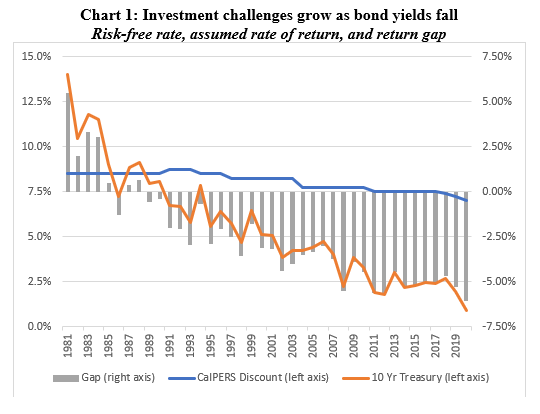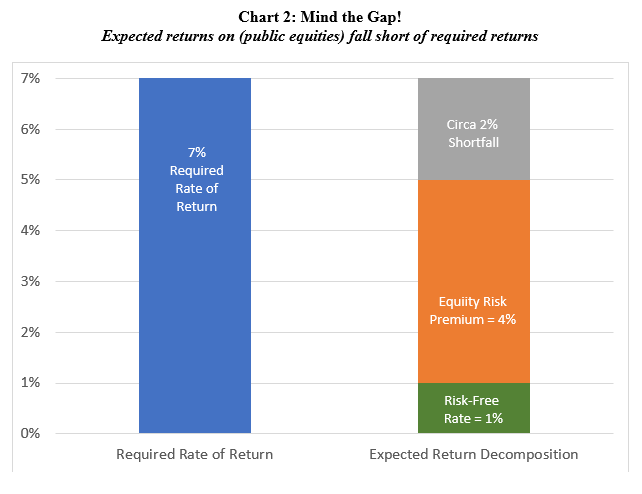Originally published at Project-Syndicate |January 15, 2020
US public pension schemes are increasingly facing funding gaps that will be difficult to close in today’s capital market environment. But with innovative strategies designed to leverage these large investor’s inherent advantages, “difficult” need not become synonymous with impossible.
SACRAMENTO – Much has been written in recent years about the plight of US public pensions. There are growing concerns about underfunded liabilities, rising implicit tax burdens, and broken promises to beneficiaries. These are not groundless fears. Many US public pensions are indeed facing severe financial pressures.
These problems have begun to fuel doubts, among both current and future pensioners, about the reliability of their benefits over time, and thus about their economic security after they retire. But there are still many ways that investment staff, sponsors, and beneficiaries could work together to restore faith in the system. The key is first to understand the challenges facing the US public pension industry. One can then start to map out strategies for putting public pensions on a sound financial footing.
THE PENSION PUZZLE
The main challenge facing the public pension industry is the high assumed rates of returns on pension assets relative to what equities or bonds are likely to deliver. Many US public pension funds expect a rate of return in the neighborhood of 7% per year. But in today’s capital-market environment, achieving that sustainably over the long term has become an increasingly daunting task.
In fact, this is not a new problem. As Chart 1 illustrates, the gap between the risk-free and assumed rate of return has been widening for the past four decades. In the 1980s, the risk-free rate (as approximated by the yield for ten-year US Treasury bonds) was often far higher than the assumed rate of return, making it relatively easy for pension funds to hit their targets. Today, however, the risk-free rate is more than six percentage points below targeted returns.

Closing the gap will require innovation, new skills, and a greater appetite for risk. But investors today face a unique challenge in the form of the “triple low”: a low real interest rate, low inflation, and low economic growth. These conditions imply that future returns will likely lag well behind historical norms.
Moreover, public pension funds also face a more idiosyncratic set of challenges, which I have dubbed the “triple high”: high expected returns, high current liabilities, and high underfunded gaps. These conditions are limiting pension funds’ investment flexibility at the same time that the triple low is tightening constraints on expected returns.
In today’s high-paced financial environment, in which markets tend to focus on quarterly results, it is important to remember that pension funds invest for the long run. A reasonable expectation of long-run equity returns is determined by the sum of the risk-free rate and the sustainable equity risk premium. Whereas the risk-free rate is below 1%, historical experience has shown the sustainable equity risk premium to hover around 4%.
Thus, as Chart 2 illustrates, the most that one can expect from a public-equity-only portfolio in the long run is a return of around 5% – well short of the 7% target.

The key point here is that public equity is the building block for pension plans, because it has the highest expected return among major liquid asset classes. And make no mistake: liquidity matters. Because public pension funds are sensitive to losses, liquidity management is crucial for preventing market drawdowns from spiraling into permanent losses.
Liquidity is also needed to ensure that pensions can pay member benefits on time, regardless of market volatility. But the need to preserve prudent levels of liquidity means that public pension funds’ investment options for increasing returns are necessarily more limited than they would be otherwise.
THE MISSING LINK
Another fundamental issue is that many US public pension funds are simply underfunded, with investable assets commonly accounting for around 70% of discounted liabilities. The problem with underfunding, of course, is that it leaves a pension plan vulnerable to market drawdowns. To mitigate the market risk, underfunded pensions must diversify, typically into assets with much lower expected returns, such as bonds. And because mature schemes require more income to pay member benefits, the long-term expected return is pushed down even lower than 5%.
So, how can pensions, especially those that are underfunded, boost returns? One answer is private equity, which is generally expected to deliver returns 1.5-3 percentage points higher than public equity, owing to the illiquidity premiums and additional returns (“alpha”) that private-equity owners can extract through operational control over the businesses in their portfolios.
Still, many skeptics argue that boosting returns through private equity is not enough to narrow public pensions’ funding and return gaps. This suggests that the only remaining option is for pension plans to start reducing their unreasonable targets for expected returns.
But lowering expected returns is not a decision that can be taken lightly. Public pensions are balanced on a three-legged stool of investment return, member benefits, and employer/employee contributions. Lowering expected returns thus would have a significant adverse effect on stakeholders such as employers and employees.
To be sure, over the past decade, policymakers have introduced measures to improve the stability of the public pension system by lowering expected returns, adopting benefit reforms, and demanding higher contributions. California’s 2013 Public Employees’ Pension Reform Act, for example, slowed the rate of benefit accruals and capped payments.
But, because these policies have resulted in meaningful increases in employer and employee contributions, it would be difficult to repeat them anytime soon. Accordingly, the onus has shifted once again to the investment leg of the stool: despite the challenges, there is an acute need to boost returns.
THE PUBLIC ADVANTAGE
Fortunately, unlocking higher returns is possible, given the inherent advantages enjoyed by public pension schemes. For starters, because public pension funds have a long-term investment horizon, and are perpetual by design, they can capture the kind of risk premiums that manifest over time, such as illiquidity and equity-risk premiums.
Moreover, pensions are asset owners, as opposed to asset managers. While asset managers are under pressure to prevent their clients from abandoning them during times of market stress, public pension funds are spared from such concerns, and thus can ride out the storms.
Because asset ownership reinforces one’s ability to pursue long-term investments, private equity – with its long tie-up periods – is an ideal asset class for public pensions. But building a suitable private-equity portfolio is no small matter. Knowing which private-equity managers to pick requires deep, specialized knowledge; and getting allocations from the best managers is often difficult. Moreover, private equity is not cheap. The top managers demand high fees, and their strategies often lack the transparency of public markets.
Nevertheless, the benefits outweigh the costs. For the disciplined and committed long-term investor, the illiquidity and manager-expertise premiums offered by private equity can be treated as durable. That is why private equity is ultimately the “better” asset.
LEVERAGING FOR GROWTH
Beyond investing in “better” assets, public pensions can also try to close the gap between expected and target returns with “more” assets. By using moderate borrowing (leverage), pension funds can increase the volume of total assets under management and thereby boost overall returns.
This option is particularly sensible in light of today’s ultra-low borrowing rates. Unlike investing in ever-riskier assets – an approach that is subject to diminishing returns, because many other investors will pile into the same strategies – borrowing to increase the size of one’s portfolio capitalizes on public pensions’ inherent advantages.
To be sure, leverage presents its own risks, such as duration mismatches between liabilities and the assets acquired, and unexpected increases in borrowing rates. But in a world of low inflation and gradual recovery, most major central banks have made clear their intention to keep borrowing rates lower for longer.
Ultimately, leverage will always be a double-edged sword that can enhance returns but also amplify losses during market setbacks. As such, it should be used judiciously and with proper risk-management provisions in place.
The final key to closing the gap is to harvest long-term returns. That may sound easy, but it actually runs contrary to human nature. Asset owners are prone to squander their advantage by reacting to short-term market volatility. It is well documented that investors tend to feel the pain of loss more strongly than the pleasure from gain. Yet unlike Odysseus, it is difficult for a pension fund manager to strap herself to the proverbial mast. Having a plan and the will to stick to it is critical, requiring discipline not just from investment staff but also from those who oversee portfolio performance, such as trustees or boards.
In other words, sustaining higher returns requires courage and a well-formed strategy. It takes courage to be different and to stay the course; and the strategy must align incentives for long-term performance.
PROCESS MAKES PERFECT
This is not a plea for dogmatism. Because the fundamentals can change, strategic asset allocations may need to adapt. Ultimately, the commitment should be to the process itself. Decision-makers must ask whether a judgment about the investment environment is solidly based. Are the read-throughs to probable returns, risks, and liquidity needs being properly analyzed? Is there a sufficient cushion, above all in liquidity, to meet the plan’s obligations? If these boxes can be ticked, the strategy ought to be maintained in the face of ordinary market setbacks and periodic underperformance.
Remember, during times of crisis, asset owners – unlike asset managers – do not face the threat of investor redemptions. With the ability to buy when others sell, they can rely on an intrinsic source of return enhancement. This was certainly the case for better-prepared funds during the financial market turmoil induced by COVID-19 last spring. And over time, this key advantage can compound and accrue to a plan’s sponsors and beneficiaries.
Closing US public pension funds’ large funding gaps will not be easy, but nor is it a lost cause. The best approaches will be based on these institutions’ intrinsic advantages as large-scale long-term investors. Improving returns is possible through “better” assets, “more” assets, and a serious commitment to long-term thinking.
To succeed, those overseeing pension schemes must recognize that improvements in risk management and in the structure of incentives are essential. Enhancing the rate of return is not possible without embracing risk. Investment staff therefore need to be equipped with the tools to identify, take on, and mitigate risk; and those who reward or constrain the investment staff need to appreciate the inherent advantages and challenges that come with being a long-term investor.
Above all, for pension plans to achieve their investment aims, they must be willing to innovate, to consider alternative assets and approaches to boosting returns, and to endure rough passages with an eye on the horizon, rather than on the obstacles immediately in front of them.
Ben Meng: Ben Meng is a former chief investment officer at CalPERS (California Public Employees’ Retirement System) and a former deputy chief investment officer at China’s State Administration of Foreign Exchange, which invests the foreign exchange reserves of China.



